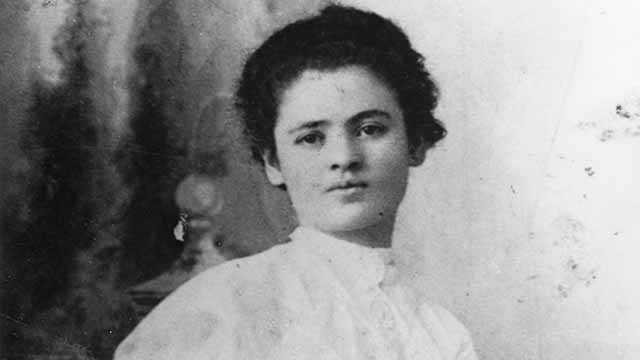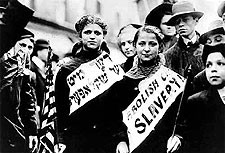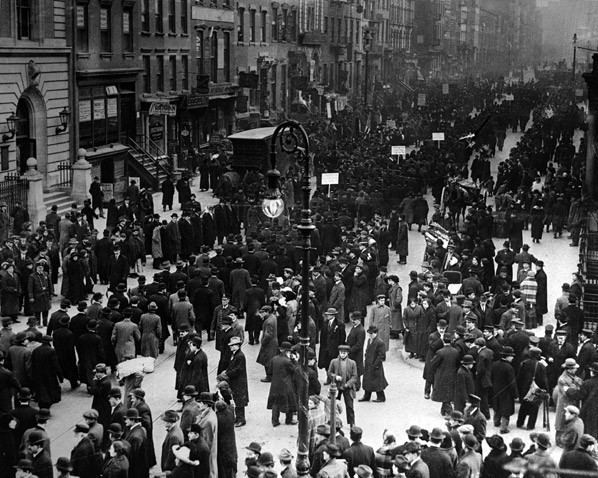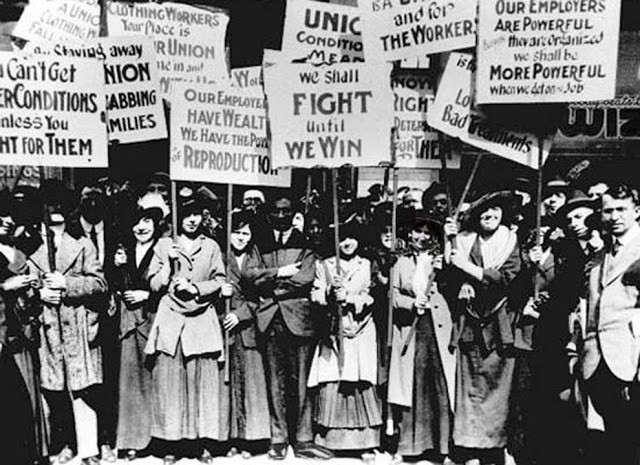Former Residence of Labor Activist Clara Lemlich Shavelson
Introduction
Text-to-speech Audio
Images
Clara Lemlich Shavelson

Shavelson at a protest

Striking garment workers in the street

Participants in the Uprising of the 20,000

Backstory and Context
Text-to-speech Audio
Clara Lemlich Shavelson was born in Ukraine in 1886 and came to the United States with her family in 1904. Like thousands of European immigrants, Shavelson and her family settled in New York City and Clara found work in a garment factory. Garment factories in the early 1900s frequently employed young women, where they often worked eleven-hour days, six days a week. A typical salary for a woman in the garment industry was often just $3 a week.
By the time she arrived in the United States as a teenager, Shavelson was already well-versed in Marxism and though she worked long hours in New York, she found time to read Russian literature and studied Marxist theory in her free time. In 1906, she joined the Ladies’ Garment Worker Union (ILGWU). She developed a reputation for her fearless willingness to speak out and to put herself in harm’s way, despite her diminutive size.
Already something of a well-known fixture at picket lines, Shavelson made her mark in 1909 at a union meeting at the Cooper Union. Speaking in Yiddish, she declared to the audience, “I am tired of listening to speakers who talk in general terms. I move that we go on a general strike!” She was just 23 at the time. The audience cheered in solidarity, and the next day, thousands of workers, many of them young women, began an eleven-week general strike of the city’s shirtwaist industry.
The Uprising of the 20,000, as it came to be known, was the largest strike by women to date in United States history. Many male union members had cautioned against the strike, arguing that it would be too costly and potentially too dangerous for women. The overwhelming majority of the strikers were young, Jewish women, with men making up a small percentage of those on the picket line. The participation of men in protesting an industry in which most workers were women guaranteed a complete work stoppage. Some estimates place almost thirty thousand workers in the streets over the course of the strike.
Over the course of the strike, there were more than 700 arrests, including Shavelson's. (Between 1906 and 1909, she was arrested 17 times.) Police brutality among the strikers was rampant, and Shavelson suffered several broken ribs. She kept her injuries to herself, fearing that her parents would forbid her from rejoining the picket line if they knew.
The strikers gained some modest concessions from employers, although many of the workers' demands for reforms were ignored. One of the city's largest garment manufacturers, the Triangle Shirtwaist Company, refused to make needed reforms. Two years after the strike, the Triangle factory would be the site of one of the country's deadliest workplace disasters, when 146 workers--some of whom had been among the 20,000--died in a fire on the building's upper floors. Many of them died when they jumped from the eighth and ninth floors, rather than remain in the building and be burned alive.
Clara married Joe Shavelson in the 1910s and the couple eventually had three children that they raised in Brooklyn. As a wife and mother, Shavelson continued her work as an activist, organizing tenant unions and rent strikes among the women in her Brooklyn neighborhood. She also joined the Communist Party and would remain a loyal member for the rest of her life, although she would later renounce her prior support of the Soviet Union. Near the end of her life, she helped organize nurses and orderlies at her retirement home into a union.
The Greenwich Village Society for Historic Preservation reports that Shavelson's residence at 278 has apparently been combined with the building at 280, with the original building still standing behind the more modern facade.
Cite This Entry
Woodham, Rebecca and Clio Admin. "Former Residence of Labor Activist Clara Lemlich Shavelson ." Clio: Your Guide to History. March 3, 2021. Accessed April 2, 2025. https://theclio.com/entry/127785
Sources
Kates, Ariel . November 29, 1909: A Frail, 23-Year-Old Woman Ignites the Strike of the 20,000 at Cooper Union , Village Preservation. November 21st 2017. Accessed March 2nd 2021. https://www.villagepreservation.org/2017/11/21/november-29-1909-a-frail-23-year-old-woman-ignites-the-strike-of-the-20000-at-cooper-union/.
Greenberg, Zoe . Overlooked No More: Clara Lemlich Shavelson, Crusading Leader of Labor Rights , New York Times . August 1st 2018. Accessed March 2nd 2021. https://www.nytimes.com/2018/08/01/obituaries/overlooked-clara-lemlich-shavelson.html.
Michels , Tony . Uprising of the 20,000 (1909) , Jewish Women's Archive . Accessed March 2nd 2021. https://jwa.org/encyclopedia/article/uprising-of-20000-1909.
Clara Lemlich and the Uprising of the 20,000, American Experience . Accessed March 2nd 2021. https://www.pbs.org/wgbh/americanexperience/features/biography-clara-lemlich/.

